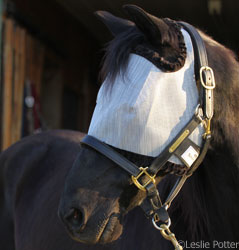
Are both you and your horse are being driven crazy by flies? The choice you make in fly control products can be made easier if you understand the different types of products that are on the market.
On the Horse
The Pyrethrins
The active ingredient in most on-animal fly applications is based on the pyrethrins, a group of chemicals found in chrysanthemums. The chrysanthemums that supply pyrethrins grow mostly in Africa, and must be hand picked and processed in order to obtain the chemical. It is this elaborate and painstaking procedure that makes pyrethrins an expensive ingredient in fly control products.
Chemical Control
There are other ingredients included in on-animal fly control products besides pyrethrins. A type of synthetic chemical known as a synergist is added specifically to make pyrethrins and other insecticides/repellents more potent. Entomologists have discovered that insects have detoxifying enzymes in their systems that can break down the pyrethrins. Synergists inhibit these enzymes, giving the product greater power to invade the insect’s body.
Covering Up
Some insects feed on the secretions of the horse’s eyes and nose. Some fly masks cover just the top portion of the horse’s face, while others also include ear covers to keep biting gnats from irritating the ears. Leg netting is another method of keeping flies from making contact with the skin.
Premise Control
- Aerosol sprays are usually administered through automatically timed systems located in each stall, periodically releasing a spray of pyrethrins-based insecticide that mists down upon the environment. The spray also mists the horse occupying the stall, protecting the animal safely.
- Feed-through products are added to the horse’s feed on a daily basis with the intent of making the manure sterile and unusable as food to fly larvae. Any larvae that is hatched in the manure produced by a horse on a feed-through product will die before it has the chance to develop. In order for the product to be effective, all the horses in a given area must be ingesting the product. Otherwise, larvae will simply hatch in the untreated manure and the fly population will go unhindered.
- Fly traps include fly strips and fly containers. Fly strips are usually yellow ribbons of sticky tape that can be suspended from stall ceilings and other areas within the stable. Flies are attracted to colors in the orange and yellow spectrum; drawn to the strip, they stick to it once they alight. Container traps usually use bait systems, where flies are attracted to a jar or bag containing water and a food or hormone bait. The fly crawls into the container, and the clear sides confuse it, since flies do not recognize glass or see-through plastic. Exhaustion overcomes the insect, and it drops into the water and drowns.
- Fly parasitoids are gaining in popularity as an effective fly control method that is both safe and gentle for the horse and the environment. The most commonly sold fly parasitoids are tiny wasps in the Chalcididae family. These wasps, which are much smaller than flies, feed on the larvae of the fly while it is still in the horse’s manure. These wasps do not bite or sting humans or other animals, and are so tiny that they are rarely even noticed.
Good Management
When all is said and done, the real secret to successful fly control is proper stable management. Frequent disposal of soiled bedding and droppings, as well as standing water, is essential to controlling flies. Stabling horses away from cattle is another way to keep flies at bay, because parasitic flies are particularly drawn to cattle, and these flies will harass horses as well. A combination of on-animal products and premise controls can do wonders to keep your horse happy, healthy and free of those pesky flies.
The author would like to thank entomologists William B. Warner and Fred W. Knapp for their assistance in preparing this article.

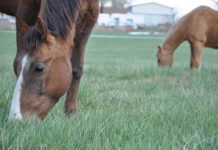
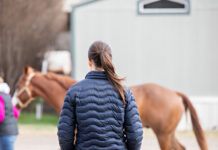
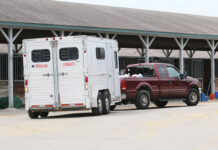

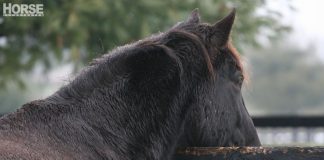

cool! this is great
It’s fly time…urghh!
i have a great tip for fly control!
maybe once or twice a week clean out your pasture of all poop flys are attracted to poop and cleaning the pastures will eliminate alot of flys!
One cheap fly trap is where you take a 2-liter bottle.Cut it off right above the label (if its a soda bottle) Turn the funnel upside down and staple it in there.(take off the lid) Put water and a little bit of soda in there. Done, cheap, easy and effective.
great tips and for petes sake you should have a fly mask and fly sheet and use the sprays so you have double action of controll on flies! Thats for sure! I have a horse who is sssssssssssssooooooooooooooo irritated that she stamps her hoofs and swishes her tail like you could not beleive and there are products for when your riding to help keep the flies away from you and your horse!
I try not to use any pesticides. I use citronella, vinegar, water & skin so soft and it works great.
Great Tips!!! i use a fly sheet/summer sheet every year for my horses but now this year i going to use the spray , shampoo and fly mask plus the sheets!
Any one have ideas on how to keep flies from the horse. My horse is such a BIG baby and he complains if there is one fly on his legs…he stomps his foot and swishes his tail like you’ve never seen before. It’s really hard to ride to when he is acting up. The person who had him before me globbed fly spray all over him when they rode. I can’t afford to buy 10 bottles a week!! Any ideas
can’t stand flies.
My horse will LOVE this!!! He HATES flies so this will be good to get flies away from him.
Great advice.
All this tells us is how to remove fly’s. Real “Horse Fly’s” don’t respond to fly sprays. The are a sight insects. How about telling us how to remove “Horse Fly’s”? I don’t have fly’s on my place. I have a proven plan that I do year round so that I don’t have fly’s, these methods don’t work for the real “Horse Fly’s”.